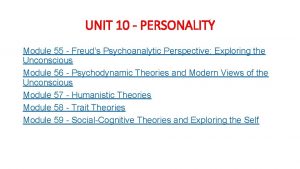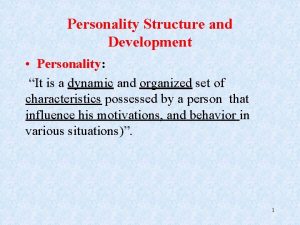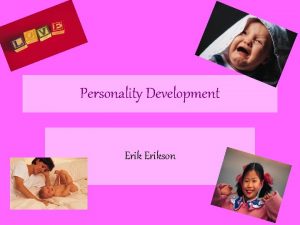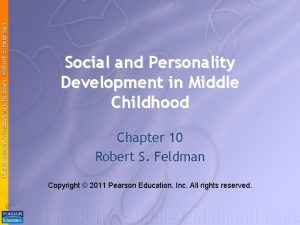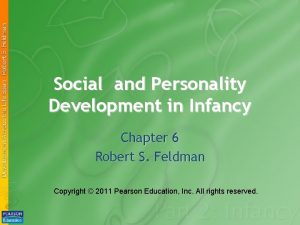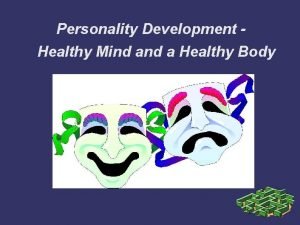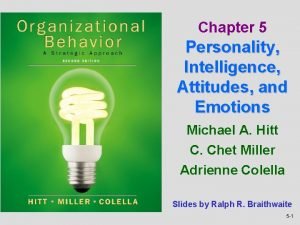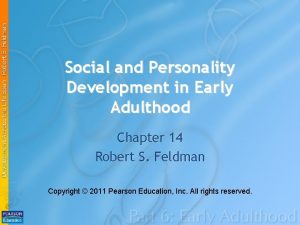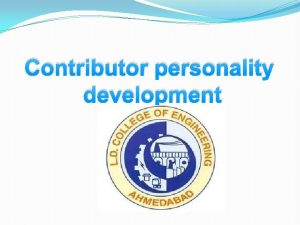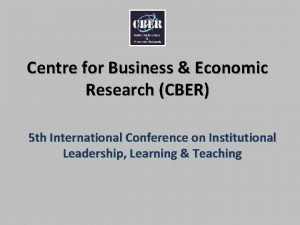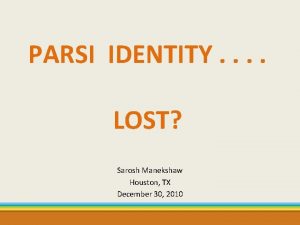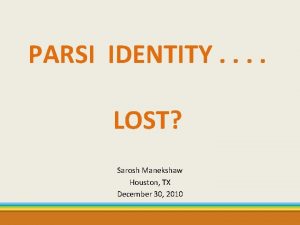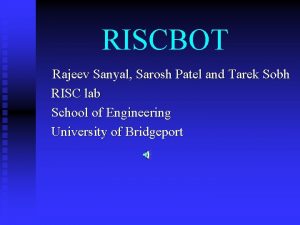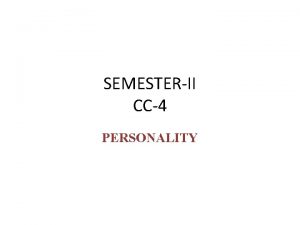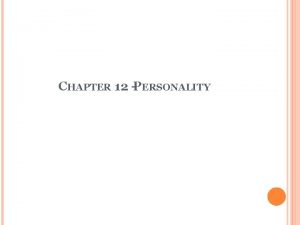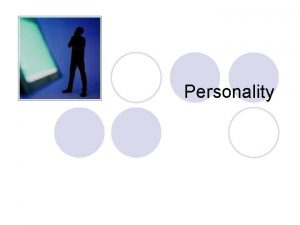Personality Development SAROSH Personality is defined as the























































- Slides: 55

Personality Development SAROSH

Personality is defined as the characteristic sets of behaviors, cognitions, and emotional patterns that evolve from biological and environmental factors. While there is no generally agreed upon definition of personality, most theories focus on motivation and psychological interactions with one's environment.

Developmental psychology The branch of psychology that studies the patterns of growth and change that occur throughout life.

Development is the sequence of age-related changes that occur as a person progresses from conception to death.

It includes both the biological and behavioral changes that take place as people grow older. An infant’s newfound ability to grasp objects, a child’s gradual mastery of grammar, an adolescent’s spurt in physical growth, a young adult’s increasing commitment to a vocation, and an older adult’s transition into the role of grandparent all represent development. These transitions are predictable changes that are related to age.

Development is a lifelong process. We’ll divide the life span into four broad periods: (1) The prenatal period (before birth) (2) Childhood (3) Adolescence (4) Adulthood

The Growth of Thought: Cognitive Development Cognitive development refers to transitions in youngsters’ patterns of thinking, including reasoning, remembering, and problem solving

Schema Well defined mental structure Equilibration Maturity of schema

Piaget & Learning • Equilibration: assimilation & accommodation • We adjust our ideas to make sense of reality • Assimilation: • Involves interpreting new experiences in term of existing mental structures without changing them. • process of matching external reality to an existing cognitive structure.

Accommodation: • When there’s an inconsistency between the learner’s cognitive structure & the thing being learned the child will reorganize their thoughts • Involves existing mental structure to explain new experiences


Piaget’s theory of cognitive development Piaget proposed that youngsters progress through four major stages of cognitive development, which are characterized by fundamentally different thought processes: (1) the sensorimotor period (birth to age 2) (2) the preoperational period (ages 2 to 7) (3) the concrete operational period (ages 7 to 12) (4) the formal operational period (age 12 onward)

Sensorimotor Stage (birth to 2) During the sensorimotor stage , children base their understanding of the world primarily on touching, sucking, chewing, shaking, and manipulating objects. In the initial part of the stage, children have relatively little competence in representing the environment by using images, language, or other kinds of symbols.

Consequently, infants lack what Piaget calls “object permanence”, the awareness that objects and people continue to exist even if they are out of sight. EXAMPLE we can observe their reactions when a toy they are playing with is hidden under a blanket. Until the age of about 9 months, children will make no attempt to find the hidden toy.

However, soon after that age (9 months) they will begin an active search for the missing object, indicating that they have developed a mental representation of the toy (object permanence). Object permanence, then, is a critical development during the sensorimotor stage.

Preoperational stage (2 to 7) Children gradually improve in their use of mental images. Although progress in symbolic thought continues, Piaget emphasized the shortcomings in preoperational thought.

Because they had not yet mastered the principle of conservation. “Conservation” is the awareness that physical quantities remain constant in spite of changes in their shape or appearance. OR “Conservation” is the knowledge that quantity is unrelated to the arrangement and physical appearance of objects.

Children who have not mastered this concept do not know that the amount, volume, or length of an object does not change when its shape or configuration changes.

Example Suppose you had two drinking glasses of different shapes—one short and broad and one tall and thin. Now imagine that you filled the short, broad one with soda about halfway and then poured the liquid from that glass into the tall one. The soda would appear to fill about three-quarters of the second glass. If someone asked you whethere was more soda in the second glass than there had been in the first, what would you say?

You might think that such a simple question hardly deserves an answer; of course, there is no difference in the amount of soda in the two glasses. However, most 4 -year-olds would be likely to say that there is more soda in the second glass. If you then poured the soda back into the short glass, they would say there is now less soda than there was in the taller glass.

Children who do not understand the principle of conservation invariably state that the amount of liquid changes as it is poured back and forth. They cannot comprehend that a transformation in appearance does not imply a transformation in amount.

According to Piaget, their inability To understand conservation is caused by some basic flaws in preoperational thinking. These flaws include : Centration, Irreversibility Egocentrism.

“Centration” is the tendency to focus on just one feature of a problem, neglecting other important aspects. When working on the conservation problem with water, preoperational children tend to concentrate on the height of the water while ignoring the width. They have difficulty focusing on several aspects of a problem at once.

“Irreversibility” is the inability to envision reversing an action. Preoperational children can’t mentally “undo” something. For instance, in grappling with the conservation of water, they don’t think about what would happen if the water were poured back from the tall beaker into the original beaker.

“Egocentrism” in thinking is characterized by a limited ability to share another person’s viewpoint. For instance, if you ask a preoperational girl whether sister has a sister, she’ll probably say no if they are the only two girls in the family. She’s unable to view sisterhood from her sister’s perspective.

Concrete Operational Stage (7 to 12) Piaget called this stage “concrete operations” because children can perform operations only on images of tangible objects and actual events. Among the operations that children master during this stage are reversibility and decentration.

Reversibility permits a child to mentally undo an action. For example, they can understand that when someone rolls a ball of clay into a long sausage shape, that person can recreate the original ball by reversing the action.

“Decentration” allows the child to focus on more than one feature of a problem simultaneously. The newfound ability to coordinate several aspects of a problem helps the child appreciate that there are several ways to look at things. This ability in turn leads to a decline in egocentrism and gradual mastery of conservation.

Although children make important advances in their logical capabilities during the concrete operational stage, their thinking still displays one major limitation: They are largely bound to the concrete, physical reality of the world. For the most part, they have difficulty understanding questions of an abstract or hypothetical nature.

Formal Operation (12 to Adulthood) In this stage, children begin to apply their operations to “abstract” concepts in addition to concrete objects. During this stage, youngsters come to enjoy the heady contemplation of abstract concepts. Many adolescents spend hours mulling over hypothetical possibilities related to abstractions such as justice, love, and free will.

Children in earlier developmental stages tend to attack problems quickly, with a trial-anderror approach. In contrast, children who have achieved formal operations are more likely to think things through. They envision possible courses of action and try to use logic to reason out the likely consequences of each possible solution before they act.

Thus, thought processes in the formal operational period can be characterized as abstract, systematic, logical, and reflective.

Cognitive Stage Age Range Major Characteristics Sensorimotor Birth– 2 years Development of motor skills, little or no capacity for symbolic representation, development of object permanence after 9 months. Preoperational 2– 7 years Development of symbolic thought marked by irreversibility, centration, and egocentrism. Concrete operational 7– 12 years Mental operations applied to concrete events; mastery Of conservation, decentration and concept of reversibility Formal operational 12 years–adulthood Mental operations applied to abstract ideas; logical, systematic thinking.

Personality refers to an individual’s unique constellation of consistent behavioral traits. OR The pattern of enduring characteristics that produce consistency and individuality in a given person.


Trust-versus-Mistrust (birth to 1½ years) In the first stage of psychosocial development, infants develop feelings of trust if their physical requirements and psychological needs for attachment are consistently met such necessities as food, a warm blanket, and changed diapers.

In this way their interactions with the world are generally positive. the child should develop an optimistic, trusting attitude toward the world. In contrast, inconsistent care and unpleasant interactions with others can lead to mistrust, pessimistic personality.

Autonomy-versus-shame-and-doubt Stage (1½ to 3 years) In the second stage, when parents begin toilet training and other efforts to regulate the child’s behavior. The child must begin to take some personal responsibility for feeding, dressing, and bathing. Child develops independence and autonomy if exploration and freedom are encouraged or shame and self-doubt if they are restricted and overprotected.

According to Erikson, the key to the development of autonomy during this period is that the child’s caregivers provide the appropriate amount of control. If parents provide too much control, children cannot assert themselves and develop their own sense of control over their environment; if parents provide too little control, the children become overly demanding.

Initiative Versus Guilt (3 to 6) In Erikson’s third stage, children experiment and take initiatives that may sometimes conflict with their parents’ rules. Over controlling parents may begin to instill feelings of guilt, and self-esteem may suffer.

Parents need to support their children’s emerging independence while maintaining appropriate controls. In the ideal situation, children will retain their sense of initiative while learning to respect the rights and privileges of other family members.

Industry-versus-inferiority (age 6 through puberty) In the fourth stage, the challenge of learning to function socially is extended beyond the family to the broader social realm of the neighborhood and school. During this period, increasing competency in all areas, whether social interactions or academic skills, characterizes successful psychosocial development.

In contrast, difficulties in this stage lead to feelings of failure and inadequacy. Or, if things don’t go well in this broader social domain, they may develop a sense of inferiority.

Identity-versus-role-confusion stage (Adolescence) During this stage, a time of major testing, people try to determine what is unique about themselves. They attempt to discover who they are, what their strengths are, and what kinds of roles they are best suited to play for the rest of their lives—in short, their identity.

A person confused about the most appropriate role to play in life may lack a stable identity, adopt an unacceptable role such as that of a social deviant, or have difficulty maintaining close personal relationships later in life.

During the identity-versus-role-confusion period, an adolescent feels pressure to identify what to do with his or her life. Because these pressures come at a time of major physical changes as well as important changes in what society expects of them, adolescents can find the period an especially difficult one.

The identity-versus-role-confusion stage has another important characteristic: declining reliance on adults for information with a shift toward using the peer group as a source of social judgments. The peer group becomes increasingly important, enabling adolescents to form close, adult-like relationships and helping them clarify their personal identities.

According to Erikson, the identity-versus-role -confusion stage marks a pivotal point in psychosocial development, paving the way for continued growth and the future development of personal relationships.

Intimacy-versus-isolation (Early adulthood) During early adulthood, people enter the intimacyversus-isolation stage. Spanning the period of early adulthood (from post adolescence to the early 30 s), this stage focuses on developing close relationships with others.

Difficulties during this stage result in feelings of loneliness and a fear of such relationships; successful resolution of the crises of this stage results in the possibility of forming relationships that are intimate on a physical, intellectual, and emotional level. Successful resolution of the challenges in this stage should promote empathy and openness, rather than shrewdness and manipulativeness.

Generativity-versus-Stagnation (Middle adulthood) Development continues during middle adulthood as people enter the generativityversus- stagnation stage. Generativity is the ability to contribute to one’s family, community, work, and society and to assist the development of the younger generation.

Success in this stage results in a person’s feeling positive about the continuity of life; difficulties in this stage lead a person to feel that his or her activities are trivial or stagnant and have done nothing for upcoming generations.

Integrity Versus Despair (Late adulthood) Finally, the last stage of psychosocial development, the ego-integrity-versus-despair stage, spans later adulthood and continues until death. Person reviews life’s accomplishments and failures. Now a sense of accomplishment signifies success in resolving the difficulties presented by this stage of life.

Failure to resolve the difficulties results in regret over what might have been achieved but was not.

Stages of Psychosocial Development
 Stick is coded as rshbj
Stick is coded as rshbj It is a collection of well-defined objects.
It is a collection of well-defined objects. How is personality defined module 55
How is personality defined module 55 Hát kết hợp bộ gõ cơ thể
Hát kết hợp bộ gõ cơ thể Bổ thể
Bổ thể Tỉ lệ cơ thể trẻ em
Tỉ lệ cơ thể trẻ em Gấu đi như thế nào
Gấu đi như thế nào Glasgow thang điểm
Glasgow thang điểm Chúa yêu trần thế
Chúa yêu trần thế Môn thể thao bắt đầu bằng chữ f
Môn thể thao bắt đầu bằng chữ f Thế nào là hệ số cao nhất
Thế nào là hệ số cao nhất Các châu lục và đại dương trên thế giới
Các châu lục và đại dương trên thế giới Cong thức tính động năng
Cong thức tính động năng Trời xanh đây là của chúng ta thể thơ
Trời xanh đây là của chúng ta thể thơ Cách giải mật thư tọa độ
Cách giải mật thư tọa độ Làm thế nào để 102-1=99
Làm thế nào để 102-1=99 độ dài liên kết
độ dài liên kết Các châu lục và đại dương trên thế giới
Các châu lục và đại dương trên thế giới Thơ thất ngôn tứ tuyệt đường luật
Thơ thất ngôn tứ tuyệt đường luật Quá trình desamine hóa có thể tạo ra
Quá trình desamine hóa có thể tạo ra Một số thể thơ truyền thống
Một số thể thơ truyền thống Cái miệng xinh xinh thế chỉ nói điều hay thôi
Cái miệng xinh xinh thế chỉ nói điều hay thôi Vẽ hình chiếu vuông góc của vật thể sau
Vẽ hình chiếu vuông góc của vật thể sau Thế nào là sự mỏi cơ
Thế nào là sự mỏi cơ đặc điểm cơ thể của người tối cổ
đặc điểm cơ thể của người tối cổ Thế nào là giọng cùng tên? *
Thế nào là giọng cùng tên? * Vẽ hình chiếu đứng bằng cạnh của vật thể
Vẽ hình chiếu đứng bằng cạnh của vật thể Phối cảnh
Phối cảnh Thẻ vin
Thẻ vin đại từ thay thế
đại từ thay thế điện thế nghỉ
điện thế nghỉ Tư thế ngồi viết
Tư thế ngồi viết Diễn thế sinh thái là
Diễn thế sinh thái là Dạng đột biến một nhiễm là
Dạng đột biến một nhiễm là Bảng số nguyên tố
Bảng số nguyên tố Tư thế ngồi viết
Tư thế ngồi viết Lời thề hippocrates
Lời thề hippocrates Thiếu nhi thế giới liên hoan
Thiếu nhi thế giới liên hoan ưu thế lai là gì
ưu thế lai là gì Hổ sinh sản vào mùa nào
Hổ sinh sản vào mùa nào Khi nào hổ con có thể sống độc lập
Khi nào hổ con có thể sống độc lập Sơ đồ cơ thể người
Sơ đồ cơ thể người Từ ngữ thể hiện lòng nhân hậu
Từ ngữ thể hiện lòng nhân hậu Thế nào là mạng điện lắp đặt kiểu nổi
Thế nào là mạng điện lắp đặt kiểu nổi Aggression defence mechanism
Aggression defence mechanism Trust vs. mistrust
Trust vs. mistrust Physical defects in personality development
Physical defects in personality development Personality development in infants
Personality development in infants Damon's stages of friendship
Damon's stages of friendship Personality development in infancy
Personality development in infancy Summary of personality development
Summary of personality development Determinants of personality development
Determinants of personality development Personality development in early adulthood
Personality development in early adulthood Non contributor example
Non contributor example Conclusion of personality development
Conclusion of personality development


